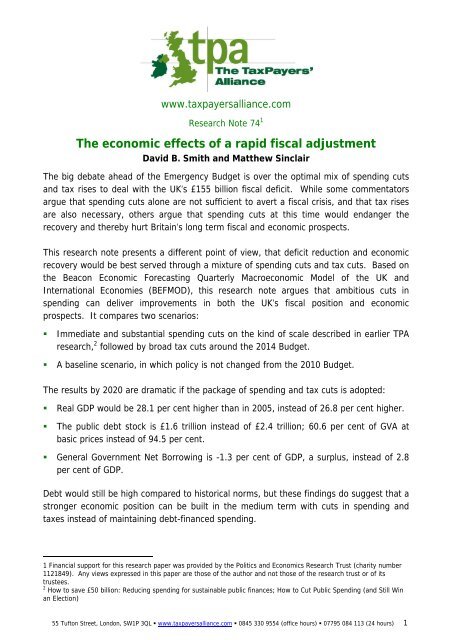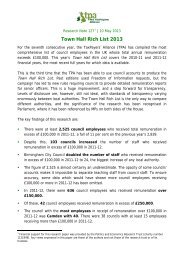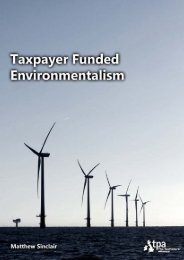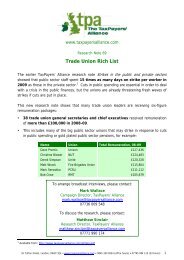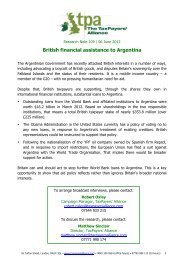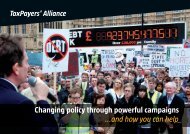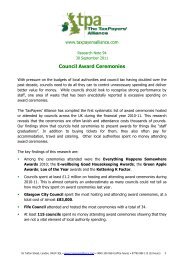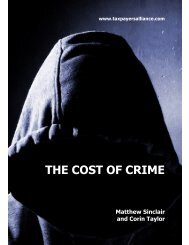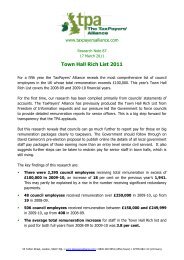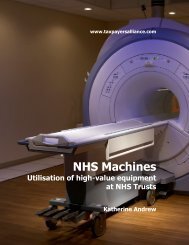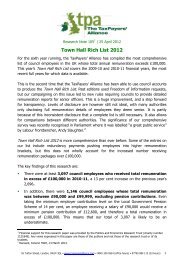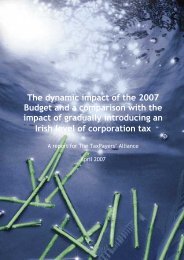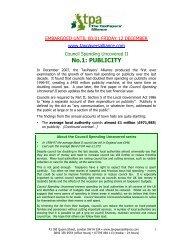The economic effects of a rapid fiscal adjustment - The TaxPayers ...
The economic effects of a rapid fiscal adjustment - The TaxPayers ...
The economic effects of a rapid fiscal adjustment - The TaxPayers ...
You also want an ePaper? Increase the reach of your titles
YUMPU automatically turns print PDFs into web optimized ePapers that Google loves.
www.taxpayersalliance.com<br />
Research Note 74 1<br />
<strong>The</strong> <strong>economic</strong> <strong>effects</strong> <strong>of</strong> a <strong>rapid</strong> <strong>fiscal</strong> <strong>adjustment</strong><br />
David B. Smith and Matthew Sinclair<br />
<strong>The</strong> big debate ahead <strong>of</strong> the Emergency Budget is over the optimal mix <strong>of</strong> spending cuts<br />
and tax rises to deal with the UK’s £155 billion <strong>fiscal</strong> deficit. While some commentators<br />
argue that spending cuts alone are not sufficient to avert a <strong>fiscal</strong> crisis, and that tax rises<br />
are also necessary, others argue that spending cuts at this time would endanger the<br />
recovery and thereby hurt Britain’s long term <strong>fiscal</strong> and <strong>economic</strong> prospects.<br />
This research note presents a different point <strong>of</strong> view, that deficit reduction and <strong>economic</strong><br />
recovery would be best served through a mixture <strong>of</strong> spending cuts and tax cuts. Based on<br />
the Beacon Economic Forecasting Quarterly Macro<strong>economic</strong> Model <strong>of</strong> the UK and<br />
International Economies (BEFMOD), this research note argues that ambitious cuts in<br />
spending can deliver improvements in both the UK’s <strong>fiscal</strong> position and <strong>economic</strong><br />
prospects. It compares two scenarios:<br />
• Immediate and substantial spending cuts on the kind <strong>of</strong> scale described in earlier TPA<br />
research, 2 followed by broad tax cuts around the 2014 Budget.<br />
• A baseline scenario, in which policy is not changed from the 2010 Budget.<br />
<strong>The</strong> results by 2020 are dramatic if the package <strong>of</strong> spending and tax cuts is adopted:<br />
• Real GDP would be 28.1 per cent higher than in 2005, instead <strong>of</strong> 26.8 per cent higher.<br />
• <strong>The</strong> public debt stock is £1.6 trillion instead <strong>of</strong> £2.4 trillion; 60.6 per cent <strong>of</strong> GVA at<br />
basic prices instead <strong>of</strong> 94.5 per cent.<br />
• General Government Net Borrowing is -1.3 per cent <strong>of</strong> GDP, a surplus, instead <strong>of</strong> 2.8<br />
per cent <strong>of</strong> GDP.<br />
Debt would still be high compared to historical norms, but these findings do suggest that a<br />
stronger <strong>economic</strong> position can be built in the medium term with cuts in spending and<br />
taxes instead <strong>of</strong> maintaining debt-financed spending.<br />
1 Financial support for this research paper was provided by the Politics and Economics Research Trust (charity number<br />
1121849). Any views expressed in this paper are those <strong>of</strong> the author and not those <strong>of</strong> the research trust or <strong>of</strong> its<br />
trustees.<br />
2 How to save £50 billion: Reducing spending for sustainable public finances; How to Cut Public Spending (and Still Win<br />
an Election)<br />
55 Tufton Street, London, SW1P 3QL • www.taxpayersalliance.com • 0845 330 9554 (<strong>of</strong>fice hours) • 07795 084 113 (24 hours) 1
Results<br />
<strong>The</strong> main difference between the two scenarios – the baseline and one in which spending<br />
and taxes are cut – is in spending. By 2011 spending is around £50 billion lower.<br />
General Government Consumption, 2010-2020, BEFMOD forecast<br />
Baseline<br />
£ billion<br />
Cuts scenario<br />
£ billion<br />
Difference<br />
£ billion<br />
2010 349 324 25<br />
2011 365 313 52<br />
2012 379 326 53<br />
2013 397 342 55<br />
2014 418 358 60<br />
2015 441 373 68<br />
2016 467 398 69<br />
2017 497 427 70<br />
2018 529 459 70<br />
2019 562 493 69<br />
2020 596 528 68<br />
In 2014-15, Value Added Tax, the basic rate <strong>of</strong> Income Tax, Corporation Tax, Employees’<br />
and Employers’ NICs and the average rate <strong>of</strong> duties and other current taxes are cut by 1<br />
per cent.<br />
Under the cuts scenario, GDP is higher by the end <strong>of</strong> the forecast period, though it is lower<br />
in earlier years.<br />
Real GDP, 2005=100, 2010-2020, BEFMOD forecast<br />
Baseline<br />
Cuts scenario<br />
2010 101.9 100.9<br />
2011 104.5 100.9<br />
2012 107.2 102.9<br />
2013 110.0 105.8<br />
2014 112.6 108.6<br />
2015 115.2 111.7<br />
2016 117.8 114.7<br />
2017 120.3 117.7<br />
2018 122.7 120.6<br />
2019 124.8 123.4<br />
2020 126.8 128.1<br />
55 Tufton Street, London, SW1P 3QL • www.taxpayersalliance.com • 0845 330 9554 (<strong>of</strong>fice hours) • 07795 084 113 (24 hours) 2
Under the cuts scenario, the outlook for the public finances is considerably better, with<br />
lower borrowing throughout the period.<br />
General Government Net Borrowing, per cent <strong>of</strong> Basic-Price GDP, BEFMOD forecast<br />
Baseline<br />
Cuts scenario<br />
2010/11 14.7 12.6<br />
2011/12 14.5 11.3<br />
2012/13 13.6 9.9<br />
2013/14 12.2 8.1<br />
2014/15 10.5 5.5<br />
2015/16 8.8 4.0<br />
2016/17 7.2 2.8<br />
2017/18 5.9 1.7<br />
2018/19 4.8 0.7<br />
2019/20 3.7 -0.3<br />
2020/21 2.8 -1.3<br />
General Government Net Borrowing, per cent <strong>of</strong> Basic-Price GDP, BEFMOD forecast<br />
16.0<br />
14.0<br />
% <strong>of</strong> Nominal GDP at Basic<br />
Prices<br />
12.0<br />
10.0<br />
8.0<br />
6.0<br />
4.0<br />
2.0<br />
0.0<br />
-2.0<br />
-4.0<br />
Baseline<br />
Cuts scenario<br />
That leads to a lower public debt stock:<br />
55 Tufton Street, London, SW1P 3QL • www.taxpayersalliance.com • 0845 330 9554 (<strong>of</strong>fice hours) • 07795 084 113 (24 hours) 3
Public Debt Stock, BEFMOD forecast<br />
Baseline<br />
Cuts scenario<br />
£ billion % <strong>of</strong> Basic-Price GDP £ billion % <strong>of</strong> Basic-Price GDP<br />
2010 787 60.0 780 60.2<br />
2011 987 71.2 939 69.0<br />
2012 1192 80.8 1092 75.2<br />
2013 1394 88.0 1232 78.8<br />
2014 1585 92.9 1351 79.3<br />
2015 1761 95.9 1437 78.1<br />
2016 1917 97.5 1505 76.1<br />
2017 2056 97.8 1555 73.1<br />
2018 2176 97.3 1585 69.4<br />
2019 2277 96.2 1593 65.2<br />
2020 2360 94.5 1577 60.6<br />
Finally, the model produces lower unemployment by the end <strong>of</strong> the forecasting period,<br />
although again there is a rise in the short term.<br />
Labour Force Survey unemployment, BEFMOD forecast<br />
Baseline thousands Cuts scenario thousands<br />
2010 2573 2596<br />
2011 2595 2726<br />
2012 2470 2629<br />
2013 2308 2470<br />
2014 2163 2319<br />
2015 2028 2158<br />
2016 1918 2020<br />
2017 1837 1895<br />
2018 1789 1802<br />
2019 1772 1740<br />
2020 1780 1710<br />
To discuss the research, please contact:<br />
Matthew Sinclair<br />
Research Director, <strong>TaxPayers</strong>' Alliance<br />
matthew.sinclair@taxpayersalliance.com<br />
07771 990 174<br />
55 Tufton Street, London, SW1P 3QL • www.taxpayersalliance.com • 0845 330 9554 (<strong>of</strong>fice hours) • 07795 084 113 (24 hours) 4
About the Beacon Economic Forecasting model<br />
<strong>The</strong> current BEFMOD can be regarded as one link in a continuous line <strong>of</strong> development that<br />
now extends back a quarter <strong>of</strong> a century. It has been used in a number <strong>of</strong> think tank<br />
reports, including Living with Leviathan: Public Spending Taxes and Economic Performance<br />
by David B. Smith for the Institute <strong>of</strong> Economic Affairs. In 2006, it topped the Sunday<br />
Times ranking <strong>of</strong> <strong>economic</strong> models.<br />
<strong>The</strong> current version <strong>of</strong> BEFMOD contains 133 quarterly variables <strong>of</strong> which 70 are predicted<br />
using econometric relationships. It has a number <strong>of</strong> distinctive characteristics:<br />
• Buffer-stock monetarism. BEFMOD has always incorporated the theoretical<br />
approach known as ‘buffer-stock’ monetarism, meaning that more attention is paid to<br />
the broad money supply both internationally and in Britain than is usual in other UK<br />
models. This means that BEFMOD’s theoretical framework is closer to that <strong>of</strong> the<br />
European Central Bank’s ‘second-pillar’ approach than the Conventional <strong>The</strong>oretical<br />
Macro<strong>economic</strong> Model (CTMM) widely employed by Anglo-Saxon economists, which<br />
ignores money entirely.<br />
• Britain is modelled as an ‘open’ economy. <strong>The</strong> British economy has always been<br />
modelled as a small open part <strong>of</strong> the wider world economy, analogous to a ‘Singapore’<br />
or ‘Hong Kong’ rather than a ‘United States’ or a ‘Euro-zone’. <strong>The</strong> power and speed with<br />
which overseas developments affect Britain mean that BEFMOD embodies a small<br />
monetary model <strong>of</strong> the aggregated ‘world’ economy, which is <strong>of</strong> interest in its own right<br />
as well as for its crucial inputs into the UK model.<br />
• Supply-side <strong>economic</strong>s. BEFMOD has also attempted to embody the insights arising<br />
from supply-side <strong>economic</strong>s, particularly the importance <strong>of</strong> the tax burden as an<br />
influence on <strong>economic</strong> decisions with respect to output, the size <strong>of</strong> the tradables sector,<br />
private-sector employment, the exchange rate and prices.<br />
• Smallness and simplicity. <strong>The</strong>re has been a general preference for the smallest and<br />
simplest model consistent with the forecasting task in hand. This reflects a general<br />
philosophical preference for comprehensible and transparent model properties. BEFMOD<br />
is not particularly small by today’s standards, however.<br />
55 Tufton Street, London, SW1P 3QL • www.taxpayersalliance.com • 0845 330 9554 (<strong>of</strong>fice hours) • 07795 084 113 (24 hours) 5


